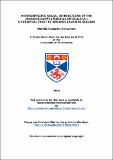Files in this item
Heterospecific social interactions of the invasive guppy (Poecilia reticulata): a potential trait to enhance invasion success
Item metadata
| dc.contributor.advisor | Magurran, Anne E. | |
| dc.contributor.author | Camacho-Cervantes, Morelia | |
| dc.coverage.spatial | 170 | en_US |
| dc.date.accessioned | 2015-04-23T15:19:32Z | |
| dc.date.available | 2015-04-23T15:19:32Z | |
| dc.date.issued | 2015-06-24 | |
| dc.identifier | uk.bl.ethos.644838 | |
| dc.identifier.uri | https://hdl.handle.net/10023/6561 | |
| dc.description | Electronic version excludes material for which permission has not been granted by the rights holder | en_US |
| dc.description.abstract | From all the species that arrive to a novel environment, very few manage to form a viable population. The guppy, a very successful invader, is a highly social species that performs some of its vital tasks (e.g., foraging, avoiding predators) in groups. This thesis aimed to quantify heterospecific association benefits that enhance invasion success. Interactions between invaders and natives could be one of the environmental characteristics of a place that increase its risk of invasion. I evaluated the tendency of an invasive species to associate with native individuals with similar ecological requirements. I tested the hypothesis that invaders gain exploring, acquisition of information and foraging benefits when socializing with natives. In these experiments I used the guppy as the invasive model species and endangered native Mexican topminnows (Poeciliopsis infans, Skiffia bilineata, Ameca splendens, Zoogoneticus tequila, Xenotoca eiseni and Girardinichthys viviparous). I found that guppies shoal with other species in Trinidad (Poecilia picta and Poecilia sphenops), where they are native (Chapter 2) and that this trait remains when they are invasive (Chapter 3). Guppies are equally willing to explore novel environments when accompanied by heterospecifics or conspecifics. Guppies are more willing to explore complex environments than simple ones. Moreover, when exploring simple environments they have a higher association tendency, regardless of the partner’ species (Chapter 4), which could lead them to acquire the benefits of grouping behaviour and avoid Allee effects - the disadvantages of being part of a small group. In the contexts in which they were tested guppies gained as much information by associating with heterospecifics as with conspecifics (Chapter 5). Finally, I found that when shoaling in bigger shoals guppies are able to locate food faster and spent more time foraging. The benefits of increased shoal size were maintained when the additional guppies were replaced with heterospecifics. However, they derive more benefits from the species they are more willing to associate with (Chapter 6). These results uncover a mechanism enabling founding individuals to survive during the most vulnerable phase of an invasion and help explain why guppies have established viable populations in many parts of Mexico as well as in every continent except Antarctica. | en_US |
| dc.language.iso | en | en_US |
| dc.publisher | University of St Andrews | |
| dc.subject | Invasive species | en_US |
| dc.subject | Behavioural ecology | en_US |
| dc.subject | Biodiversity conservation | en_US |
| dc.subject.lcc | QL638.P73C2 | |
| dc.subject.lcsh | Introduced organisms | en_US |
| dc.subject.lcsh | Animal behavior | en_US |
| dc.subject.lcsh | Biodiversity conservation | en_US |
| dc.title | Heterospecific social interactions of the invasive guppy (Poecilia reticulata): a potential trait to enhance invasion success | en_US |
| dc.type | Thesis | en_US |
| dc.contributor.sponsor | Consejo Nacional de Ciencia y Tecnología (CONACyT) (Mexico) | en_US |
| dc.type.qualificationlevel | Doctoral | en_US |
| dc.type.qualificationname | PhD Doctor of Philosophy | en_US |
| dc.publisher.institution | The University of St Andrews | en_US |
This item appears in the following Collection(s)
Items in the St Andrews Research Repository are protected by copyright, with all rights reserved, unless otherwise indicated.

